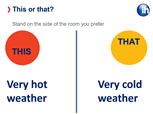Following on from the four inclusive icebreakers we saw in part 1 of this series, here are another four ideas for first lessons which help learners get to know each other and form the bonds with the rest of the class that will make the lessons which follow so much more successful.
5. We are the World
For this activity, you’ll need either a big world map or, if you have access to technology, a Padlet World Map. The aim of the activity is for students to work together to put pins on as many countries as possible within a set time-limit. Students can compete in groups against each other or they can all work together to beat the clock.
To be able to put a pin on a country, they need to justify how the group has some connection to that country. In a class with a range of nationalities, they can start by putting a pin where each student comes from, but after that (or with mono-cultural classes), students need to be creative in thinking about how they might be connected to certain countries. For example, they may choose Thailand because they someone in their group recently ate Thai food, or they might choose Canada because they watched videos by a Youtuber from there.
At the end, each group has to summarise the connections, either as a spoken or written task.
6. This or That?
This popular game requires students to choose between two things, depending on which they prefer.
You should assign opposite sides of the classroom either “this” or “that”. Then you can show students a Powerpoint with two things they must choose between and they have to walk to the corresponding side of the room. Once there, invite any student who feels like doing so to say more about their choice.
If you don’t have access to technology, you can simply read the two options. If you’re teaching online, it may be easier to use a poll to do this, or share your PPT and students can type “this” or “that” in the chat. You can repeat this with as many two-option questions as you like, but it’s important not to choose anything too divisive such as politics, favourite celebrities, sports etc.
Again, this activity shows what the class has in common, whilst also showing it’s ok to be different.

7. Solve a problem
Students who feel less confident about their English skills can feel very stressed during icebreaker activities so it can be a good idea to run a group activity which involves different skills and ways of thinking, as well as English.
Brainteasers or riddles which need to be solved by a group can allow different learners to shine by utilising their skills and therefore highlighting to everyone the importance of diverse skills in a group. Here's an example of a problem which can be displayed and the students can discuss it together to try to find the solution:
“A farmer has a dog, a sack of grain and a live chicken, all of which he must take across a river. The boat will only carry him and one of the things at a time or it will sink. Without the farmer, the dog would kill the chicken, and the chicken would eat the grain. How does he get all three across safely to continue his journey? “ (The answer is below!
8. Design a class motto / flag / shield
Ask the learners to work together to design something which can represent the whole class and can be used throughout the year, such as a motto or shield which can be displayed on physical or virtual classroom walls.
They can choose any design they want, provided it represents everyone in the class, and it does not include any offensive images. Again, this is a task which requires a diverse range of skills such as design and teamworking and helps students get to know each other while working towards a common objective.
Still hungry for ideas?
Here are some links with other great activities for first lessons:
More icebreaker activities are suggested in this blogpost from National Geographic: https://infocus.eltngl.com/2017/07/07/classroom-ice-breakers-elt/
You can find some downloadable activities for first lessons in this article from Oxford University Press : https://oupeltglobalblog.com/2019/08/29/10-back-to-school-ideas/
Macmillan’s Onestopenglish.com also has some downloadable speaking activities for first lessons here: https://www.onestopenglish.com/download?ac=63031
This recent article from Cambridge University Press has some ideas for first lesson activities too: https://www.cambridge.org/elt/blog/2021/08/18/good-start-with-new-class/
A list of ideas for first lessons from teachers around the world can be found in this article by Pearson English: https://www.english.com/blog/5-first-day-activities/
Answer to problem in 7: The farmer takes the chicken to the other side (side 2). He then goes back and takes the dog to side 2, leaving it there but taking the chicken back with him to side 1. He leaves the chicken on side 1, takes the grain to side 2, and then goes back to get the chicken and bring him to side 2.


